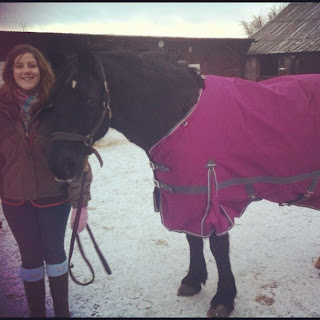Mechanisms
Horses have adaptation to help keep them warm during the cold weather. The first one of these is their coat. The fur can stand on end to trap an extra layer of air when the weather is cold. This is called piloerection and the layer of air acts as extra insulation. The coats also has oils in it which makes it water-proof. Therefore, unless they are in the wet weather for a prolonged period of time it will not go through to their body causing them to get cold. Donkeys have a very different coat to horses as they are more adapted for warmer climates, their fur is much finer and they do not have the same oily coat.
They can shiver which uses the muscles more and produces heat. Mejdell and Boe (2005) looked at how Icelandic horses were responding to Nordic winter conditions.Around 40 horses were looked at for 23 days and only one horse was seen to shiver. During the period, the temperature went down to -31 degrees Celsius. The horses were found to use their shelter more when the temperature was colder or when it was rainy or windy. Their body condition scores remained within normal ranges. It was concluded that even in these temperatures, it did not pose much of a challenge on the horses. Therefore shivering may only occur when the temperature is very cold. Shivering may be more likely if the horse is wet as they will be losing a lot of extra heat.
Their blood vessels can also constrict to prevent blood going to the surface and the heat being lost though the skin. It is thought that sweating inhibition may be partly due to vasoconstriction.
Nutrition
Horses respond to the temperature in their environment by acclimatisation. The metabolic rates of horses in chronic cold have been found to increase by around 70% (Cymbaluk, 1994). Horses may need their digestible energy intake to be increased when they are in very cold conditions due to the increase in metabolic rate and using the energy to keep warm. However, over the summer they build up a store of fat which can be used in the winter when food may be more scarce or they may need the energy to keep warm. Horses will spend more time eating or searching for food in the winter due to their increased energy demands. This links back to my post on leptin.
Clipping Horses
We clip horses in the winter due to their thick winter coats making them too hot when we ride them. I think clipping horses in the winter is a concept some people that don't have horses find confusing.
When horses are clipped they lose the layer of air that the fur can hold onto as an extra layer of insulation. It is also more likely that rain will go down to their skin and not run off the surface. This is why they need to wear rugs to compensate for this.
However, it has been found that clipping is beneficial to horses being exercised during the winter as they will recover more quickly after exercise and will not sweat as much.
Different breeds will be able to cope with cold temperatures to different extents. This is due to what the breed as adapted to cope with. For example, Icelandic horses have evolved to live in cold climates and Welsh cobs and ponies are adapted to living on mountains. However, Thoroughbreds are not well adapted for cold temperatures. This will reflect in the management of these different breeds during cold temperatures such as the rugs they where or what they will need to be fed.
Thermal Imaging
I was just searching for an equine thermal imaging picture and I found this one. When I clicked on the website (click here) I saw it was a gadget you could buy to look at your own horse. I don't really know where you buy it from or how much it costs but it sounds like a good idea to me because one of the first ways most injuries are detecting are via feeling heat coming from the area.
In the summer I wrote a post on how horses regulate their temperature to keep warm. Click here to go to the blog post. After writing this I then also did a post on Heat stroke and Acclimatisation.
Also take a look at the giveaway I am running to win a headcollar... Click here.
Love Laura
xxxx



1 comment:
Very interesting, I am well aware of the difference in breeds due to keeping 3 TB’s, one native pony and a gypsy vanner, our ponies are going out with no rugs on in snow and are still warm.
The thermal imaging cameras I have seen are nearing £900 for the cheapest one and can go all the way up to £28,000 but I am sure if I was to do more searching I would be able to find a cheaper one, I think it would be good too.
Regards
Edward
Post a Comment